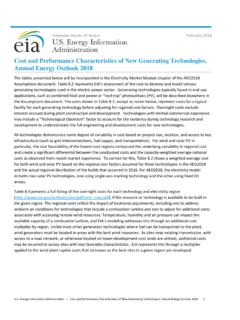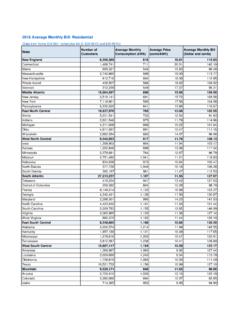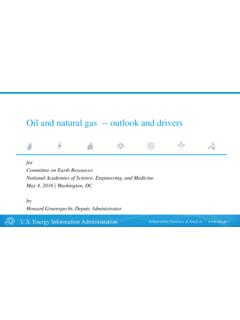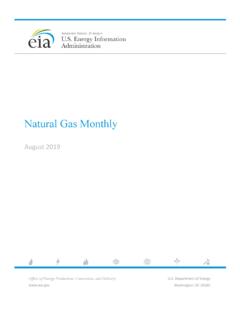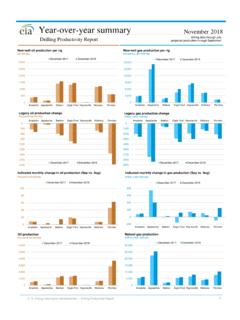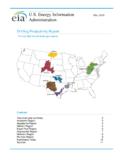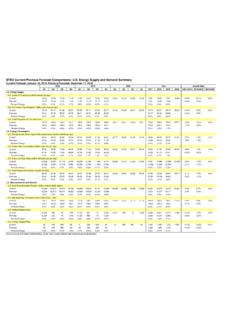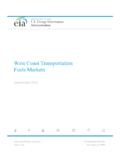Transcription of Chapter 6 Buildings sector energy consumption
1 energy Information Administration | International energy Outlook 2016 Chapter 6 Buildings sector energy consumptionOverviewEnergy consumed in the Buildings sector consists of residential and commercial end users and accounts for of the total delivered energy consumed worldwide. consumption of delivered, or site, energy contrasts with the use of the primary energy that also includes the energy used to generate and deliver electricity to individual sites such as homes, offices, or industrial plants. In the International energy Outlook 2016 (IEO2016) Reference case, delivered energy consumption in Buildings worldwide increases by an average of from 2012 to 2040. In the non-Organization for Economic Cooperation and Development (non-OECD) nations, consumption of delivered energy in Buildings grows by from 2012 to 2040, nearly three times the growth rate for the OECD sectorEnergy consumption in the residential sector includes all energy consumed by households, excluding transportation It includes energy used for heating, cooling, lighting, water heating, and consumer products.
2 energy consumption in the residential sector is affected by income levels, energy prices, location, building and household characteristics, weather, efficiency and type of equipment, energy access, availability of energy sources, and energy -related policies, among other factors. As a result, the type and amount of energy consumed by households can vary significantly within and across regions and the IEO2016 Reference case, residential sector energy use accounts for about 13% of total world delivered energy consumption in 2040. Delivered energy consumption in the residential sector grows by an average of from 2012 to 2040, increasing by a total of 48% over the entire period. Residential energy use in the non-OECD nations increases by an average of from 2012 to 2040 in the Reference case and accounts for 80% of all growth in world residential energy use over the 28-year period.
3 OECD residential sector energy use grows much more slowly, averaging over the same period, but residential energy consumption per capita remains higher in OECD countries than in non-OECD countries through becomes an increasingly important energy source for the residential sector throughout the projection period. The electricity share of world residential energy consumption grows from 39% in 2012 to 43% in 2040, and by 2025 electricity surpasses natural gas as the leading source of residential delivered and India continue to lead world residential energy demand growth in the IEO2016 Reference case, mainly as a result of their relatively fast-paced economic growth. In 2040 their combined residential energy consumption is more than double their 2012 total and accounts for nearly 27% of total world residential energy residential energy consumptionFor the OECD region, residential energy consumption increases by an average of from 2012 to 2040 in the IEO2016 Reference case (Figure 6-1).
4 The lower growth rate in comparison with other world regions is a result of relatively slow growth in gross domestic product (GDP) and population, as well as improvements in building shells and the efficiency of appliances and equipment. The OECD share of the world s residential energy consumption declines from in 2012 to in 2040, as demand rises among the emerging economies of the non-OECD. Over the projection period, OECD residential energy use per capita grows by an average of (Figure 6-2).In the IEO2016 Reference case, as demand for household electronics increases, electricity surpasses natural gas as the largest source of energy for OECD residential use, accounting for 43% of total residential consumption in 2040. Accordingly, the shares of fossil fuels, including natural gas, liquid fuels, and coal, decrease.
5 Residential sector electricity demand grows by an average of over the projection period and natural gas consumption grows by , compared with a decline of for coal and liquid AmericasResidential energy consumption in the countries of the OECD Americas (United States, Canada, Chile, and Mexico) accounts for one-fourth of the world s total delivered residential energy consumption in 2012. The United States is by far the largest consumer of residential energy in the OECD Americas, accounting for 84% of the OECD Americas total in 253 Total delivered energy used in the residential and commercial sectors includes electricity, natural gas, liquid fuels, coal, and marketed renewable energy ( , solar thermal energy ). OECDU nited StatesJapanCanadaOECD EuropeSouth KoreaAustralia/New ZealandMexico/ChileFigure 6-1.
6 Average annual change in OECD residential sector energy consumption , 2012 40 (percent per year) energy Information Administration | International energy Outlook 2016102 Buildings sector energy consumption2012 and 80% in 2040. Residential energy consumption in the United States remains steady between 2012 and 2040 as state and federal energy efficiency standards for consumer products, other efficiency programs, and sectoral changes offset drivers that would otherwise increase residential energy they consume far less energy than the United States, the economies of Chile and Mexico grow more rapidly than the other parts of the OECD Americas from 2012 to 2040. The combined residential energy consumption of Mexico and Chile grows by an average of annually from 2012 to 2040, compared with in the United States.
7 Mexico and Chile together have the highest projected growth rates in GDP (as measured in purchasing power parity terms) in the OECD region, at from 2012 to 2040, compared with for the OECD overall. This strong economic growth leads to improvement in standards of living and increased residential demand for space heating and air conditioning and other energy -consuming household products. In 2012, petroleum and other liquid fuels accounted for the largest share of residential energy use in Mexico and Chile (Figure 6-3). In the Reference case, their share declines from 55% in 2012 to 32% in 2040. Electricity becomes the major residential energy source for Mexico and Chile combined, increasing from 37% of their total energy use in 2012 to 60% in EuropeMany countries in OECD Europe have instituted measures to improve energy efficiency in the residential sector .
8 Those efforts, along with relatively low economic growth and slow population growth, contribute to the slow increase in the region s residential energy use through 2040. Households in OECD Europe accounted for 21% of the world s total residential energy consumption in 2012, but their share falls to 18% in 2040 in the IEO2016 Reference case, with the region s total residential sector energy demand increasing by an average of only Electricity is OECD Europe s fastest-growing source of residential energy in the IEO2016 Reference case, with consumption growth averaging from 2012 to 2040, while natural gas consumption grows at a rate of AsiaThe total residential demand for energy in OECD Asia increases by an average of in the IEO Reference case.
9 Japan accounts for the largest share of residential energy use in OECD Asia throughout the projection, although its share declines from 63% in 2012 to 56% in 2040. In Japan, residential sector energy consumption grows by annually from 2012 to 2040 in the Reference case, with GDP growing by and population declining by The residential sector accounts for more than one-third of total electricity consumption in Japan, mostly from the use of residential electronic appliances. Electricity remains Japan s main residential energy source throughout the projection, increasing by from 2012 to residential energy consumptionResidential energy consumption in the non-OECD countries accounted for less than 50% of the world s total residential energy use in 2012. Their share grows to nearly 60% in 2040 in the IEO2016 Reference case, as a result of generally faster economic and population growth than in the OECD countries.
10 Total residential sector demand for energy in the non-OECD countries increases by an average of in the Reference case, led by an average annual increase of in India from 2012 to 2040 (Figure 6-4). Electricity consumption leads the increase in non-OECD residential energy use. Electricity s share grows from 31% in 2012 to 47% in 2040, as many emerging economies transition from traditional fuels to marketed fuels, and the quality of life improves with access to modern sources of energy , especially OECDU nited StatesCanadaAustralia/New ZealandOECD EuropeJapanSouth KoreaMexico/ChileFigure 6-2. Average annual change in OECD residential sector energy consumption per capita, 2012 40 (percent per year)0%20%40%60%80%100%Mexico/ChileAustr alia/New ZealandSouthKoreaOECDE uropeJapanRenewablesNatural gasElectricityLiquidsCoal201220402012204 0201220402012204020122040 Figure 6-3.

